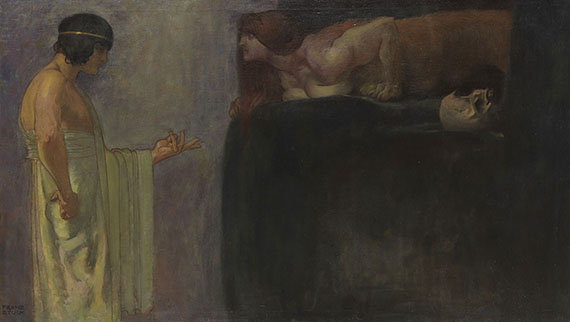Dictionary


Pre-Raffaelites
A movement of its own right was the group of the Pre-Raphaelites, English painters that congregated under the name "Pre-Raphaelite Brotherhood" in 1848 (the abbreviation PRB was used as a signature in the movement's early days). The impetus for the group's foundation, similar to the Nazarenes, was a dissatisfaction with the prevailing study conditions at the art academies, where Raffael's art had been made the guiding star. As their name hints at, the Pre-Raphaelites saw art before Raffael as their real reference.
Biblical subjects that illustrated the words of the bible and conveyed emotions, landscapes, genre scenes and portraits belonged to the group's range of topics. Allegoric figures played an important role, they were often borrowed from literature, such as in "Ophelia" (1851-52) by John Everett Millais (1829-96), one of the most famous Pre-Raphaelite paintings.
The importance of nature as a main source of inspiration is a common feature, nature was depicted with a great love for the detail, following the motto of John Ruskin "rejecting nothing, selecting nothing". This meticulousness in painting was accompanied by the development of photography, which took place at around the same time.
Another important representative, besides Millais, was Dante Gabriel Rossetti (1828-82). Others were James Collinson, William Dyce, William Holman Hunt, Frederick Sandys and Ford Madox Brown.
A movement of its own right was the group of the Pre-Raphaelites, English painters that congregated under the name "Pre-Raphaelite Brotherhood" in 1848 (the abbreviation PRB was used as a signature in the movement's early days). The impetus for the group's foundation, similar to the Nazarenes, was a dissatisfaction with the prevailing study conditions at the art academies, where Raffael's art had been made the guiding star. As their name hints at, the Pre-Raphaelites saw art before Raffael as their real reference.
Biblical subjects that illustrated the words of the bible and conveyed emotions, landscapes, genre scenes and portraits belonged to the group's range of topics. Allegoric figures played an important role, they were often borrowed from literature, such as in "Ophelia" (1851-52) by John Everett Millais (1829-96), one of the most famous Pre-Raphaelite paintings.
The importance of nature as a main source of inspiration is a common feature, nature was depicted with a great love for the detail, following the motto of John Ruskin "rejecting nothing, selecting nothing". This meticulousness in painting was accompanied by the development of photography, which took place at around the same time.
Another important representative, besides Millais, was Dante Gabriel Rossetti (1828-82). Others were James Collinson, William Dyce, William Holman Hunt, Frederick Sandys and Ford Madox Brown.
Offers
Headquarters
Joseph-Wild-Str. 18
81829 Munich
Phone: +49 89 55 244-0
Fax: +49 89 55 244-177
info@kettererkunst.de
Louisa von Saucken / Undine Schleifer
Holstenwall 5
20355 Hamburg
Phone: +49 40 37 49 61-0
Fax: +49 40 37 49 61-66
infohamburg@kettererkunst.de
Dr. Simone Wiechers / Nane Schlage
Fasanenstr. 70
10719 Berlin
Phone: +49 30 88 67 53-63
Fax: +49 30 88 67 56-43
infoberlin@kettererkunst.de
Cordula Lichtenberg
Gertrudenstraße 24-28
50667 Cologne
Phone: +49 221 510 908-15
infokoeln@kettererkunst.de
Hessen
Rhineland-Palatinate
Miriam Heß
Phone: +49 62 21 58 80-038
Fax: +49 62 21 58 80-595
infoheidelberg@kettererkunst.de
We will inform you in time.




